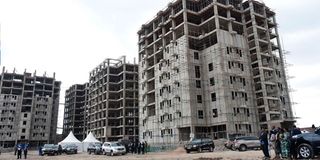The good, bad and the ugly of President Ruto's affordable housing plan

An ongoing affordable and social housing project at the former Metrological site in South B, Nairobi on October 3, 2022.
The Housing Fund is showing early signs of becoming President William Ruto's first-term legacy.
Billed as a programme that will solve the country's housing crisis while providing jobs to about a million people a year, President Ruto has marketed the idea as a do-or-die proposition.
But, with its proposal to forcibly deduct three per cent of workers' salaries and a similar amount from employers (capped at Sh5,000 per month), the programme has drawn sharp criticism from workers, employers and economists who question its priority and practicality.
After analysing government documents, speeches by various officials and arguments by economists on the housing agenda, Nation can now reveal who stands to gain, who stands to lose and the risks that lie ahead if the government's idea goes through.
Real estate developers stand to get free land to put up houses on, tax incentives on construction inputs they use and guaranteed market for the houses they construct, and banks that will lend them money and are assured of repayment, with interest, in the contracts signed between the government and developers will be biggest winners.
Small and Medium-sized Enterprises (SMEs) that will also get a market to supply construction inputs such as doors and windows and beneficiaries who will finally be homeowners at low-interest cost will benefit from the programme.
But workers, whose salaries will be chopped by three per cent (up to Sh2,500) monthly will face less take-home pay while employers’ costs will go up as they match employees’ contributions to the fund.
Also on the loser’s list are homeowners who default on repayment as they will be thrown out regardless of how much they had paid.
Employees who don’t wish to continue with contributions after the mandatory seven years will only be allowed to withdraw their own contributions, leaving the other half paid by their employers in the kitty.
Sh36bn wage bill
Taxpayers will be burdened by an extra Sh36 billion on the wage bill as a result of the programme.
In the proposed Affordable Housing Programme (AHP), the government will commit in writing to buying all the houses that developers build under the scheme, as well as providing them with free serviced land and tax breaks to reduce their construction costs.
"The AHP will also provide for an offtake agreement to purchase units from developers at a fixed price on completion of construction. The offtake agreement will remove the uncertainty of sales, making affordable housing projects more attractive to investors. In addition, with the assurance that units will be purchased, developers will build more units on a larger scale," the government said in a document.

Complete units constructed by the National Housing Corporation as part of the government's affordable houses project.
A developer will be able to go to a bank and secure a loan simply by holding the offtake agreement signed with the fund.
It is also proposing a framework for signing commercial agreements for developers to buy construction inputs such as cement and steel in bulk and at discounted prices while getting approvals at a central location.
The government estimates that about Sh9 billion will be collected.
“With Sh9 billion a month, I can start projects in every corner of this country without worrying about what the investor says, because I can tell the investor to use his money to build, give me the keys and in exchange for the keys, I give [the investor] the money,” Housing Principal Secretary (PS) Charles Hinga said.
After the government buys the houses in bulk from developers, it then proposes to issue cheap mortgages to citizens at an average interest rate of five per cent, with a repayment period of up to 30 years and monthly instalments between Sh2,500 and Sh15,000, according to various government sources.
Tenant Purchase Scheme
Intended beneficiaries will be people living in informal settlements and low-income earners, and the scheme will be run through a national Tenant Purchase Scheme, where an aspiring and qualified homeowner will have to register at the Boma Yangu portal.
The government also says that the AHP's financing framework will be aligned with a current framework used by the Kenya Mortgage Refinance Company, working with financial institutions to extend the tenure of traditional mortgages and allow Kenyans earning above the affordable housing bracket to access cheaper mortgages.
There is still no defined income bracket for affordable housing in the documents released by the government. President Ruto argues that the programme is key to massive job creation and that the mandatory contributions are not a tax, an argument that economists have disagreed with.

Housing PS Charles Hinga addresses a press briefing on the housing levy at State House, Nairobi flanked by State House spokesperson Hussein Mohamed.
“The question we need to ask ourselves is which plan will give us the opportunity to employ our youth and remove the shame of them staying on the streets and falling into drugs,” he said in a recent interview with media houses.
The President has also appeared to blame Kenyans in the formal workforce for not wanting to contribute to the economic upliftment of slum dwellers and other poor citizens but has not explained what will happen if the houses the government buys in bulk from developers do not find buyers or if the poor citizens who buy them default.
Civil society organisations have opposed the deduction of workers on the basis of the government’s history of poor management of funds, which puts workers’ money at risk, with little assurance that people will get their money back.
“It’s a bit problematic to say that contributors will get their money after seven years ... We know the struggle retirees seeking their pensions go through, what makes those who will be looking for their money from this fund be different?” Mr Sam Orlando of Pamoja Trust posed.
The government has also not been open about why it has chosen to provide free serviced land and tax exemptions to developers to build the houses before they are bought, and not to build the capacity of the National Housing Corporation (NHC) and the Ministry of Housing to do the job, where the funds used would be properly audited by the Auditor-General.
A 2013 Kenya National Bureau of Statistics (KNBS) survey showed that, of the 9.18 million households then, 5.9 million lived in houses they owned while 3.28 million lived in rentals. The Housing Survey Report of 2012/2013 showed that only 5.3 per cent of the 9.18 million (486,578) households lived in shanties. Over six million households, constituting more than two-thirds of the total, lived in bungalows, maisonettes or flats, the survey stated.
By 2019, Kenya had about 12.2 million households, about 32 per cent since 2013. While there is a lack of comprehensive data on slums, the number of shanties (about 642,282) has grown at par with other house categories. President Ruto says about six million Kenyans are currently living in slums.
Unsustainable
Institute of Economic Affairs CEO Kwame Owino said the programme will not be able to create the number of jobs claimed and that the fund will not be sustainable because the government is proposing to build houses on its own if people don't want them.
"If we have not created jobs from the 14 million houses and the big tower blocks in Nairobi, who is telling you that building 1,000 units in Siaya County will create jobs? We are lying to ourselves," he said.
Mr Owino also takes issue with a proposal to issue mortgages cheaper than the cost of funds in the economy under the AHP, warning that, sooner or later, the government will have to pump taxpayers' money into the fund to cover shortfalls as the fund won't be a sustainable venture.

President William Ruto with grader operator Patrick Mbindyo during the groundbreaking ceremony for the proposed Shauri Moyo 'A' affordable housing project on January 27, 2023.
The state aims to build around one million homes in five years, with an average of 200,000 homes a year. Some of the houses will be targeted for the social housing programme, the lowest level, and the others for AHP. For both categories, the key qualification is to be a low-income earner.
Different government officials and documents have differed on what exactly homeowners under the scheme will pay in monthly instalments, with documents putting it between Sh3,000 and Sh15,000, but the President in a recent interview with media houses put it at between Sh2,500 and Sh12,000.
The government has also argued that the AHP will develop the local industry by promoting the use of locally sourced and available materials and services, where small businesses will grow as mass production of housing units requires a stable supply chain to provide various inputs. This would be key for the local jua kali sector to find a market, one of the main challenges facing the sector today.
It is not yet clear what framework the government will use to deliver the houses to the targeted Kenyans, and how flexible it will be in involving private lenders, as the government has indicated that one of its objectives is to catalyse private finance into the programme, given the risks associated with lending to the informal sector and the low-interest rates it has announced.
There is already an ongoing programme initiated by President Ruto late last year to clear millions of Kenyans listed in Credit Reference Bureaus for defaulting on loans they had taken out. Most of the Kenyans listed for poor loan repayment were in the low-income bracket, and the government struck a deal with lenders to halve their debts.
The government remains tight-lipped on what course it would take if lenders insist on due diligence to avoid exposing themselves to huge risks by extending cheap mortgages to a population they have traditionally considered risky, or if Kenyans fail to take up the houses, which would leave the programme holding hundreds of thousands of houses without a market.





